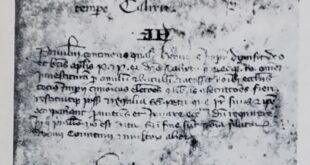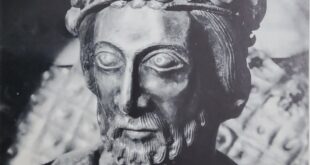Pope Leo IX reforms the church and only just in time, to prevent disaster.
The successors of William I
William I had ruled both in England and Normandy, but at his death the inheritance was divided. The ancestral duchy on the Continent went to his eldest but feckless son, Robert; and the newly conquercd island kingdom to his second son, William Rufus, or William II. For England, despite the subsequent notoriety of William II, the arrangements were beneficial. Whatever his faults as a man and his harshness as a king, William Rufus maintained the royal authority unimpaired, suppressing the baronial revolts which followed the Conqueror’s death and holding the northern frontier with Scotland. In comparison with even the strongest of Continental kingdoms, England enjoyed a priceless advantage in the incontestable position of the central monarchy. In twenty years, William I made ever more sure that his son was strong and intelligent enough to capitalize on it. However, his means to this end and the oppressiveness of his ministers provoked the discontent both of the baronage and the people at large. Yet his position was further strengthened in 1096 when he won control of Normandy, when his indigent brother Robert pledged the duchy to the king to finance his participation in the crusades.
William Rufus had no more bitter enemy than the Church, which objected not only to his personal morals, but more vehemently, to his refusal to fill vacant sees while channeling their revenuces into the royal exchequer. Indeed, much of William’s ill repute with posterity stems from the bad press he got from the ecclesiastical chroniclers. William had made Anselm, Archbishop of Canterbury during an illness that terrificd him with the fear of death. His father had forbade the English clergy to appeal to Rome without royal permission and his brother who succecded him was to fight hard — and largely successfully — to maintain the royal claim to invest bishops. William Rufus, by his unyielding opposition to Anselm and the papacy, sturdily upheld the rights of the Crown.

William Rufus was killed while hunting in the New Forest on August 2, 1100, by an arrow fired by one of his companions; the speed which his younger brother showed in taking advantage of this turn of events has led to speculation that Henry may have been prepared for what happened. Whatever the circumstances of his succession, however, there can be no doubt that the reign of Henry I was of lasting advantage for England. It is a remârkable and crucial fact that for the first seventy years of its existence, the Norman kingdom of England was ruled by three strong-willed and efficient kings whose principal enemies were the Church and the discontented elements of their own Norman baronage. Such English resistance as there was, was effectively contained, but for the most part the conquered nation seems to have accepted royal oppression as preferable to the dangers of an uncontrolled baronage. Not only did the young Henry succeed in usurping the claims of his older brother, Robert, to the kingdom, but in 1106, with an army in which the AngloSaxon infantry was a vital element, he won final control of the duchy of Normandy at the victory of Tinchebrai. Even so, during the rest of his reign, Henry had to face threats to his position in Normandy.
Growth of Central Government
In England, with the help of such great ministers as Roger, bishop of Salisbury, Henry introduced a system of financial and judicial administration that was to leave the mark of its reforms on English life for centuries to come. The exchequer, founded under Henry I, exercised a more effective control over the officers and finances of the English king than that enjoyed by any other European sovereign, while the quality of royal justice was such that even members of the nobility were prepared to pay handsomely for it. Once the system of traveling royal judges, “the justices in eyre,” was launched, the power of the king’s court came to be felt throughout the land.

Yet for all the efficiency and strength of Henry’s monarchy, he did not seek to eliminate either the baronage or the Church — the two great mainstays of a feudal monarchy. The quality of medieval government depended on the quality of the king and when Henry died at the end of 1135, an era of strong government had come to a close. Henry had planned for his daughter Matilda, wife of the former Emperor Henry V, to succeed him and had compelled his leading subjects to swear allegiance to her. However, Matilda’s claim was contended immediately after Henry’s death by her cousin Stephen of Blois, a powerful man in England, thanks to lands received from Henry himself. A decisive body of the English baronage, affronted by the prospect of petticoat rule, offended by the imperious and haughty nature of the ex-Empress and no doubt well aware of the pliant good nature of Stephen, renounced their oaths of allegiance to Matilda. In 1136, after he had granted a charter of liberties to the Church far in excess of anything conceded by his predecessors, Stephen was recognized by Pope Innocent II. Matilda did not abandon her claim and there followed a decade of civil war which left an indelible mark on the memory of England. Stephen’s own weakness and chivalry were delightedly traded upon; and the nobility of England could hardly believe their luck in having on their hands a fully fledged civil war in which the rival claimants were only too eager to bid for their support.
Undoubtedly the gloom of the period is heightened by the paucity and bias of our sources. Nevertheless, it was undoubtedly a difficult period, which only ended in 1147 when Matilda retired to Normandy, which had been taken over by her second husband, Geoffrey of Anjou. In 1153 their twenty year old son, Henry, Duke of Normandy, Anjou and Maine; and also of Aquitaine by virtue of his marriage to its duchess, Eleanor, went to England, where he found many supporters. King Stephen, broken by the death of his own eldest son, acknowledged Henry as heir to his throne. When he died the following year, the crown passed without dispute to a young man who was to prove himself one of England’s greatest rulers.

Emperors and Popes before Canossa
Thanks to the hard policy of William I and his successors, England maintained a firm stand against the claims of the reformed papacy and in 1106 Henry I, won a compromise settlement much to his advantage. In the Empire, the struggle was both longer and much more bitter, if only because the principles at stake affected the plenitude of papal power in the most obvious way. It was one of the ironical aspects of the events leading up to Canossa that the papacy, inflicted such dramatic humiliation on the Emperor. Henry IV, had been saved from its own incompetence and corruption only a brief thirty years before by his father, Henry III. The scandalous corruption of the monastic arm of the Church had been siowly cauterized during the tenth century by the great reform movement launched by the founding of Cluny. Despite this and despite the rising tide of popular piety throughout Europe, the papacy remained in a parlous state. For the first forty years of the eleventh century, it was virtually the dynastic toy of Roman families and the sin of simony, was not unknown at papal elections.
Lay intervention was essential if reform was to be successful in the body of the secular Church, where bishops and clergy were so closely involved in the secular world itself. The Emperor Henry II, fully aware of his power in church and state, had sponsored a series of synods to spur the Church to reform itself. The movement was interrupted by the reign of the Emperor Conrad II, but under his son, Henry III (1039-56), the problems of the papacy were solved. Henry IIIsucceeded in ensuring the election of his cousin, who known to later ages as St. Leo IX, was to be a chief architect of the reformed Church, which was soon to challenge the pretensions of the Emperor himself.
The Normans in Sicily
Six years before William Duke of Normandy embarked for his momentous invasion of the Chriistian island of England, with the papal blessing on his banners, two members of a family of the petty Norman nobility had begun their conquest of the Moslem island of Sicily, also with papal blessing. Despite their humble origins, Robert and Roger de Hauteville were the founders of a Mediterranean power, which throughout the twelfth century, was to hold at bay the forces of the Pope and Emperor of the West and prove dangerous enemies to the Emperor of the East.

The Norman presence in southern Italy began in the 1010s when a group of Norman pilgrims were recruited as mercenaries in the perpetual struggle among the last outposts of the Byzanune Empire, the Lombard principalities and the independent cities of which Naples was the leader. By 1030, their leader had received the fief of Aversa from the Duke of Naples. In the 1040s, Robert Guiscard “The Cunning” of the family of Hauteville appeared in Calabna to begin a career of merciless but brilliant brigandage, that bv 1059, had forced a reluctant papacy to recognize his position in the treaty of Melfi. Leaving his brother Roger to complete the conquest of Sicily, Guiscard set out in the 1080s, on a conquest of the Byzantine Empire itself, but died before his plans could materialize. After his death, his state in southern Italy soon fell apart.
Roger, however, who died in 1101, was able to leave a well-ordered and powerful kingdom in Sicily. This kingdom reached the height of its power and prestige under the rule of his second son, Roger II (1105-54). A true Hauteville in his ambition and in his ruthlessness, Roger nevertheless recognized the realities of power in his island kingdom, in which a small group of conquerors found themselves ruling a motley population in which Catholics from France and Italy rubbed shoulders with Orthodox Byzantine Christians and Islamic Saracens. Throughout their history, the rulers of Norman Sicily, who soon brought the mainland territories into their kingdom, exercised a degree of religious toleration remarkable in Europe. Displaying to the full the Norman talent for assimilation, Roger II, not only instituted a harem, but also provided himself with a first-class fleet, which enabled him and his Successors to pursue an imperial policy. In the 1130s, exploiting a papal schism, Roger was able to have himself recognized as king — a title which, though it was granted by an anti-pope, he vindicated and later had confirmed by the true Pope.

At his death, Roger II left a seemingly powerful kingdom, one whose eclectic culture was to make a notable contribution to the twelfth-century “renaissance”.
Through the silk industry of Palermo, founded by workers captured by raids on Byzantine territories, he brought the secret of silk to Europe. His sensual successor, William I, was swift to put down rebellion and left the kingdom intact.
William II (1166-89), called the Good because of the degree of internal peace that he maintained, followed the traditional policy of his house against the Byzantine Empire. To further it, he married his daughter Constance to the future Emperor Henry VI. William’s ambitious policy eventually failed however and after his death the kingdom passed to the Empire. The marriage he had arranged was to have fateful conscquences for the future of southern Europe.
























